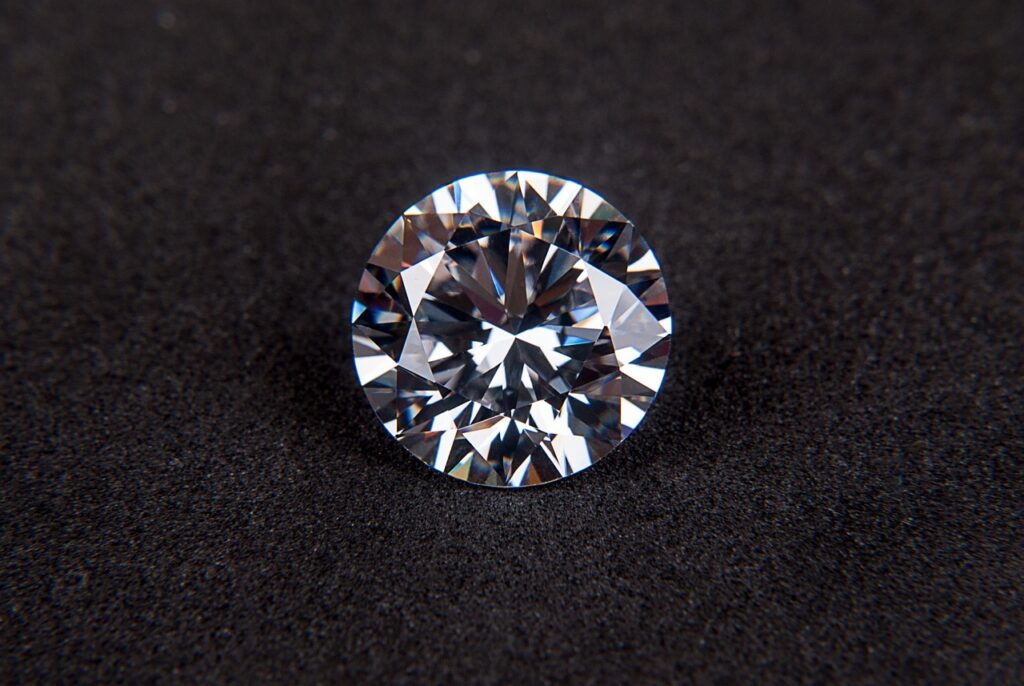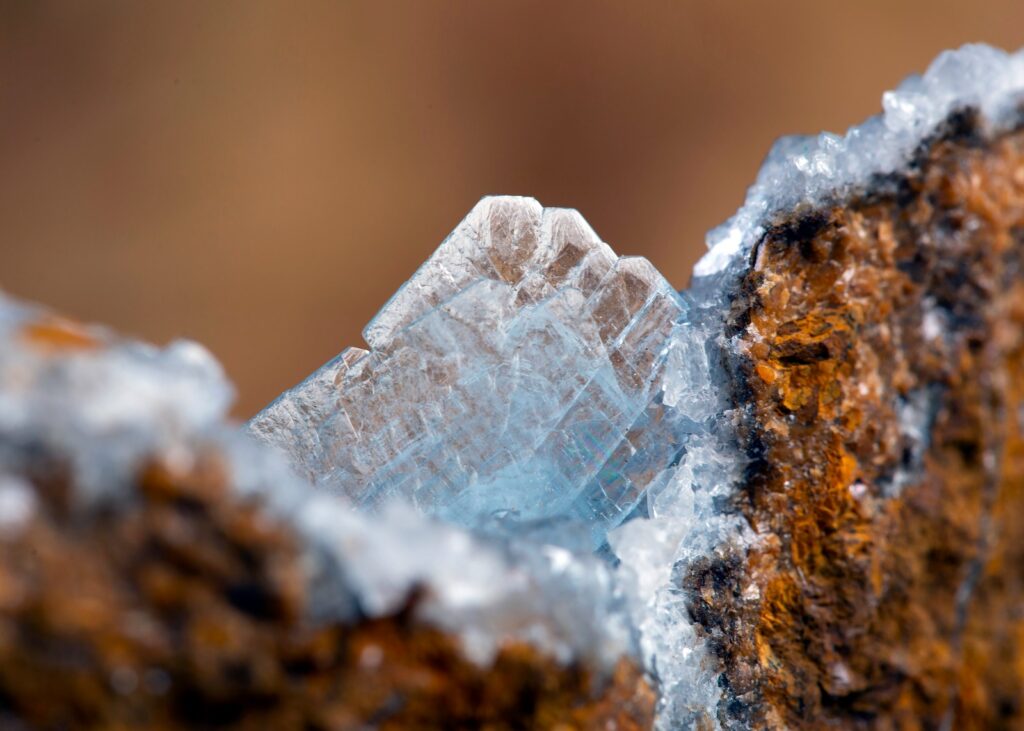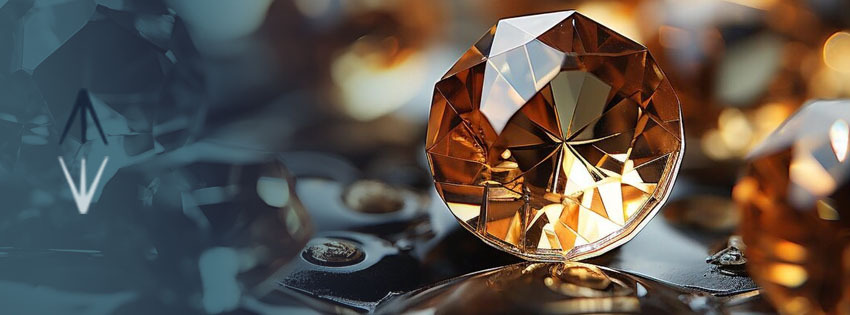The diamond is more than a precious stone; it is a wonder of nature known for its exceptional physical and optical properties. This post explores the main characteristics that make diamonds one of the most valued and studied materials in the world of gemology and industry.
Properties of a Diamond
Diamonds, beyond their renowned beauty in jewelry, possess impressive characteristics that stand out in the mineral kingdom and confer them surprising applications beyond luxury. This article explores two fundamental aspects of diamonds that underline their uniqueness both in the physical and chemical fields. On one hand, we will analyze their physical properties, which include the famous hardness that places them at the top of the Mohs scale and their exceptional thermal conductivity, making them indispensable allies in industrial applications. On the other hand, we will discuss their chemical properties, highlighting their amazing chemical inertia that allows them to withstand extremely corrosive conditions without alteration. These properties not only make diamonds virtually eternal in their form and shine but also extremely valuable in technological and scientific sectors.

What are the Physical Properties of a Diamond?
The physical properties of a diamond refer to those characteristics that can be observed and measured without changing the chemical composition of the material. In the case of diamonds, these include:
Physical Properties of a Diamond
Hardness: Diamond is the hardest known natural material, reaching a 10 on the Mohs scale. This exceptional property is due to the strong cohesion among carbon atoms in a tetrahedral crystal structure, where each carbon atom is equidistantly bonded to four other carbon atoms.
Density and specific weight: Diamonds have a density of about 3.5 g/cm³, which provides them with significant weight compared to other minerals of similar size.
Thermal conductivity: Diamonds are excellent conductors of heat, with a thermal conductivity that surpasses that of any other known material, reaching up to 2,000-2,500 W/mK. This means that diamonds can rapidly dissipate heat, which makes them useful in applications that require efficient heat removal.
Optical transparency: Diamonds have a wide range of transparency, from ultraviolet to far infrared. This makes them ideal for applications that require materials with high optical clarity, such as lenses and other components in precision instrumentation.

What are the Chemical Properties of a Diamond?
The chemical properties of a diamond describe its behavior in the presence of other materials or under certain chemical conditions, without referring to its physical state. For diamonds, these properties include:
Chemical Properties of a Diamond
Composition: Diamond is an allotrope of carbon, where each carbon atom is covalently bonded in a crystal structure that is extremely stable and compact.
Chemical inertia: Diamonds are remarkably chemically inert. They do not react with most acids and bases, making them resistant to corrosion and suitable for applications in harsh chemical environments.
Corrosion resistance: Due to their chemical stability, diamonds do not corrode or oxidize when exposed to the environment, ensuring that their brilliance and structure remain intact over time.
Behavior at high temperatures: Although stable and durable, diamonds can burn at temperatures above approximately 850°C in the presence of oxygen. However, in the absence of oxygen, they can withstand much higher temperatures without decomposing, making them useful in high-temperature industrial applications.
These physical and chemical properties make the diamond not only prized as a gem in jewelry but also as an invaluable material in industrial, optical, and scientific applications. Its unique combination of hardness, thermal conductivity, chemical inertia, and aesthetic beauty places it in a class of its own both in the natural world and in the technological realm.
What is the Mohs scale and what score does diamond have?
The Mohs scale is a mineral hardness scale that classifies minerals based on their ability to scratch softer materials. Diamond is at the top of this scale with a score of 10, making it the hardest known natural material.
Why are diamonds good conductors of heat?
Diamonds have an atomic structure that facilitates extremely rapid heat movement through their structure, making them the best conductors of heat among all natural materials.
What makes a diamond disperse light into colors?
The high dispersion of diamond is due to its exceptionally high refractive index. This allows light passing through to break down into the colors of the visible spectrum, creating an effect known as “fire” in jewelry.
Can diamonds withstand high temperatures?
Yes, diamonds can withstand extremely high temperatures. However, if exposed to intense heat (such as during a fire), they can transform into graphite or burn completely.
Are all diamonds good electrical insulators?
In their pure state, diamonds are excellent electrical insulators. However, certain impurities, such as boron, can turn them into semiconductors, making them useful in electronic applications.
How do impurities in a diamond affect its properties?
Impurities can alter everything from the color to the electrical properties of a diamond. For example, the presence of boron can give a diamond a blue tint and turn it into a semiconductor.
What industrial applications do diamonds have apart from jewelry?
Diamonds are used in the industry for cutting, drilling, and polishing due to their hardness. They are also crucial components in equipment requiring optical precision and in the manufacture of semiconductor devices.
Can a diamond be destroyed or damaged?
Despite their hardness, diamonds can be damaged by strong impacts at specific points in their crystal structure. They can also suffer damage from exposure to drastic temperature changes.
Conclusions on the Properties of a Diamond
The properties of the diamond, from its unsurpassed hardness to its exceptional optical transparency, make it a precious stone and a technical material of immense value. Whether in the crafting of a stunning jewel or as a component in an industrial setting, the diamond continues to be one of the most versatile and admired materials in various applications.
Each of these properties not only contributes to the beauty and desire to possess this gem but also drives innovation in multiple fields, from electronics to industrial machinery, proving that the diamond is truly more than just a status symbol.




